A high priority of well-known journalist Rahul Singh during his frequent travels in India and abroad, is to visit local libraries. Singh’s report on an eclectic mix of libraries across India which he checked out last year
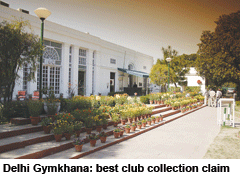 One of my first priorities when I visit a habitation on my frequent travels in India and abroad, is to head straight for the best library in town. This practice began around 1950, at age ten, in Kasauli, a military cantonment 6,000 ft above sea level in the foothills of the Himalayas. Kasauli was established by the British as a military cantonment in the early 19th century, to take on the Sikhs, their last major adversaries, before they subjugated the Indian sub-continent (they had just defeated the Gurkhas of Nepal). Thereafter, it became a ‘hill station’ for British families, apart from remaining a cantonment and, as in all such hill stations, a British-style club sprang up.
One of my first priorities when I visit a habitation on my frequent travels in India and abroad, is to head straight for the best library in town. This practice began around 1950, at age ten, in Kasauli, a military cantonment 6,000 ft above sea level in the foothills of the Himalayas. Kasauli was established by the British as a military cantonment in the early 19th century, to take on the Sikhs, their last major adversaries, before they subjugated the Indian sub-continent (they had just defeated the Gurkhas of Nepal). Thereafter, it became a ‘hill station’ for British families, apart from remaining a cantonment and, as in all such hill stations, a British-style club sprang up.
The club had a fairly well-stocked library, with a bias, as was to be expected in a cantonment, towards military history. But there were plenty of Enid Blytons, Arthur Ransomes and Richmal Cromptons (author of the William series of books), the staple reading for many of my English-educated generation. My (maternal) grandfather had bought a house in Kasauli from a departing Briton just after independence, and the club library was where I spent much of my time during the summer holidays from school. Sadly, the Kasauli Club library, along with the club house, burnt down a decade ago but has been restored with a generous endowment from the army and local residents. Meanwhile, the Delhi Gymkhana Club library — another regular haunt — has grown from strength to strength, boasting, according to its chief librarian Harish Negi, the largest — and probably best — club collection countrywide.
 I daresay most of my generation had their main “library experience”, as I did, in the club libraries of cantonments like Kasauli, and hill stations such as Shimla, Mussoorie, Ranikhet, Ooty and Kodai-kanal. The books one read there, in the early years after independence, were of course heavily Anglo-centric. Yet, at least, a love for books of all kinds and for reading in general, was ignited in us.
I daresay most of my generation had their main “library experience”, as I did, in the club libraries of cantonments like Kasauli, and hill stations such as Shimla, Mussoorie, Ranikhet, Ooty and Kodai-kanal. The books one read there, in the early years after independence, were of course heavily Anglo-centric. Yet, at least, a love for books of all kinds and for reading in general, was ignited in us.
Many of these club libraries have now expanded their activities, with regular talks by writers. When I visited the Delhi Gymkhana recently, a notice announced that Tarun Tejpal, the founder/editor of news magazine Tehelka, would be talking about his latest novel Valley of Masks. Three years ago, the Bangalore Club invited me all the way from Mumbai to discuss the November 2008 terror attack on the city. Scholar and writer Ramchandra Guha is another regular invitee to address clubs all over the country.
With the invention of new age technologies, the old-school definition of libraries has changed. Once they were buildings in which fine and rare, along with regular book collections were housed. Today, e-books can be downloaded onto your kindle or nook and the term can include not just books, but digital material, maps, microfilm, compact disks (CDs), cassettes, DVDs, audio-books, and similar electronic gadgets. But so far as I am concerned there’s no beating the good old-fashioned printed book — still my constant companion in the age of the Amazon kindle.
The need for libraries or storehouses of information and knowledge was felt centuries ago. Clay tablets in cuneiform script, rooms full of them, from the ancient city-state of Sumer, were probably the first ‘libraries’. Ancient Egypt maintained temple records on papyrus. But libraries in the modern sense really began in Greece in the 5th century BC in Athens and Rhodes. When Augustus became emperor of Rome in 27 BC, there were public libraries near the Roman forums, and the philosopher Cicero (106-43 BC) maintained his own private library.
In the 6th century AD, the great libraries of the Mediterranean sprang up in Constantinople and Alexandria, the books stocked being mainly in Greek and Latin. With the advent of Christianity, however, classical works in these two languages became obsolete and were replaced by Christian literature. Mean-while, at the other end of the world, an imperial library was set up by the Chinese Quing dynasty, the catalogue written on scrolls of silk.
The greatest library of the ancient classical world was undoubtedly the Royal Library of Alexandria in Egypt. Built in the 3rd century BC, it flourished under the Ptolemaic dynasty until the Roman conquest of Egypt in 32 BC. Then, during a visit of Julius Caesar, this unique centre of learning was accidentally burnt down. Till then, it had been the first library to have gathered books from beyond the country’s borders. The library had a walkway, gardens, a reading room, lecture halls and meeting rooms — in fact, it became a prototype for libraries of today. The Royal Library also hosted international scholars and centres for research in mathematics, physics, natural sciences and other subjects. It was associated with renowned figures of the classical world like Archimedes and Euclid.
In the popular imagination, at least of non-Muslim societies, Islam is associated with military prowess rather than learning. However, in the wake of Islamic conquests in the Middle East, North Africa, Sicily and Spain, a veritable flowering of learning took place when the Islamic world became the centre of civilisation. Libraries in places like Aleppo, Carthage and Palermo were great hubs of enlightenment.
In the 8th century AD, the craft of paper-making was imported from China into the Islamic world (the first paper mill came up in Baghdad) and libraries sprang up in Islamic cities, where works in Persian, Greek, Latin and Sanskrit were translated into Arabic. This was the golden age of Islamic scholarship, when most of Europe had sunk into the dark ages of virtual barbarism.
In India, too, the Mughals were renowned for their imperial libraries (kitabkhaneh). On ascending the throne in Delhi, one of the first initiatives of Emperor Shah Jahan was to enter his beloved kitabkhana and inscribe his name on some manuscripts of his choice. The Rampur Raza library, probably one of the most magnificent structures of any library worldwide, which I visited in the 1970s, was started by Nawab Faizullah Khan in the 18th century and built up by successive nawabs. It is now an important treasure house of Indo-Islamic cultural heritage.
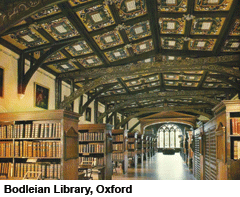 The coming of age of the modern library can be dated to Johann Gutenburg’s invention of moveable type in the 15th century, which revolutionised book-making. The Gutenburg Bible was the first printed book and from thence began the golden age of libraries, when the number of books produced shot up as their unit costs plummeted. The Bodleian Library at Oxford, the Library of the British Museum, the Mazarine Library and the Bibliotheque Saint Genevieve in Paris, the National Central Library in Italy, the Prussian State Library, and the State Public Library of St. Petersburg, all bloomed in that era.
The coming of age of the modern library can be dated to Johann Gutenburg’s invention of moveable type in the 15th century, which revolutionised book-making. The Gutenburg Bible was the first printed book and from thence began the golden age of libraries, when the number of books produced shot up as their unit costs plummeted. The Bodleian Library at Oxford, the Library of the British Museum, the Mazarine Library and the Bibliotheque Saint Genevieve in Paris, the National Central Library in Italy, the Prussian State Library, and the State Public Library of St. Petersburg, all bloomed in that era.
In India, it was the British who started modern libraries. Notwithstanding Macaulay’s notoriously famous comment that there was more learning in the single shelf of a European nobleman’s library than in the entire East, it must be said to the credit of British rule in India that, unlike other colonial powers, they promoted education for “the natives”.
In the recently published biography of Kariamanikkam Srinivasa Krishnan, one of the greatest Indian scientists of the 20th century (he collaborated with physics Nobel Prize winner C.V. Raman and should have shared that prize with him), there is a touching and telling passage of his formative years in the small Tamil town of Srivilliputtur. In 1875, even before two high schools came up in the town, the district collector, J.B. Pennington, helped the academic-minded residents to buy government land and set up shops for local traders, the rent from which funded the library. From such small beginnings are great scientists nurtured. The library was named after Pennington and 130 years on, it still exists and is similarly funded.
However, the single largest benefac-tor in the world, as far as libraries are concerned, was American philanthropist and donor Andrew Carnegie. Over a century ago, he discerned the import-ance of public libraries as centres of enlightened learning, and made an irresistible offer to communities all over the US: provide the land and money for annual maintenance and he would fund the library. He went on to donate the equivalent of an astounding $3 billion (Rs.14,400 crore in today’s money) between 1881-1917 to build 1,689 libraries across the USA, helping to educate generations of Americans, in perhaps one of the most far-sighted philanthropic initiatives ever made.
There seems to be no reliable estimate of the total number of libraries in India — nor of how many people they employ — but they must run into the thousands, if you include libraries in villages and small towns. I visited some half-a-dozen libraries in Delhi, Mumbai and Benares, for the purposes of this feature, admittedly not nearly enough to get a comprehensive picture of the state of libraries nationwide, yet sufficient to understand what works and what doesn’t.
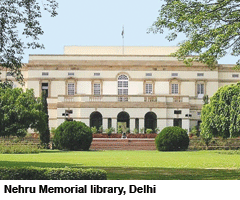 The Nehru Memorial Museum and Library, which was started relatively recently in 1964, beginning with the collection of India’s first prime minister, is housed in a serene and beautiful modern building and has all the necessary infrastructure — well-lit reading rooms, neatly arranged books, even a cyber café. Its governing body is extremely high-powered, dominated by senior officials and politicians. Glossy, well-printed brochures are brought out, but the library itself, currently in the throes of controversy over the appointment of its director, reeks of red tape.
The Nehru Memorial Museum and Library, which was started relatively recently in 1964, beginning with the collection of India’s first prime minister, is housed in a serene and beautiful modern building and has all the necessary infrastructure — well-lit reading rooms, neatly arranged books, even a cyber café. Its governing body is extremely high-powered, dominated by senior officials and politicians. Glossy, well-printed brochures are brought out, but the library itself, currently in the throes of controversy over the appointment of its director, reeks of red tape.
I had made a prior appointment, mentioning the purpose of my visit. Yet, I was kept waiting for half an hour and when I expressed my impatience, was taken to the wrong person. Assistant librarian Radhey Sham, who was clearly more comfortable speaking in Hindi, rather than English, took me around with great enthusiasm, reeling off impressive statistics: the library has a collection of 191,995 photos that are being digitised, 258,380 books and 18,223 rolls of microfilm. However, on the two occasions I visited the library, I saw few students and researchers using it (one plus point was a large female staff). When I asked the whereabouts of the chief librarian, I got an evasive answer. Verdict: A great library, but needs to be more professionally run.
 The Asiatic Library of the Asiatic Society is Mumbai’s best-known library, the origins of which date back to 1804. Built in the classical style, it is fronted with imposing Grecian-style columns, with a series of broad steps leading up to it. Inside, the walls are lined with busts, portraits and statues of its main benefactors, British and Indian (mostly Parsi). A vast Durbar Hall, with a ceiling so high, it could easily take another two floors, is where lectures are delivered.
The Asiatic Library of the Asiatic Society is Mumbai’s best-known library, the origins of which date back to 1804. Built in the classical style, it is fronted with imposing Grecian-style columns, with a series of broad steps leading up to it. Inside, the walls are lined with busts, portraits and statues of its main benefactors, British and Indian (mostly Parsi). A vast Durbar Hall, with a ceiling so high, it could easily take another two floors, is where lectures are delivered.
I used to visit the library regularly in the 1960s in my early years as a journalist, for reference material. Students could be found sitting outside, on its well-lit steps, reading books, probably because they didn’t have electricity at home. The library boasts over 3,000 precious manuscripts in Persian, Urdu, Sanskrit, Prakrit and Arabic, and rare first editions of anti-quarian books in Indian and European languages, but the jewel in its archives is a 14th century illustrated manuscript of Dante’s Divine Comedy in the original Italian (there are only two in existence). Italian dictator Benito Mussolini offered £1 million for it, but the offer was refused. Membership of the library was restricted to Europeans until 1840, when Sir Maneckji Cursetji became the first non-European member.
According to Jyotsna Sawant, who has a Masters degree in library science, the library is frequented by researchers, students and the general public. She was reluctant to give me more information and thrust some material on me, insisting that I seek an appointment with the honorary secretary of the library. It turned out that the honorary secretary only came to office on certain days. A quick look around showed a musty and poorly-lit main room which must get very hot during the summer months, while a major part of the building was under repair (halted, I was later told, due to lack of sufficient funds). Verdict: A great reference library but in urgent need of renovation and modernisation.
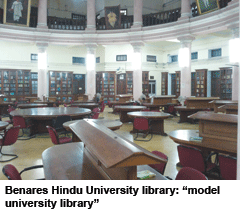 Benares Hindu University (BHU) has perhaps the loveliest and greenest campus in the country. And it also has one of the best university libraries. I couldn’t meet the chief librarian, Dr. A.K. Srivastav, but what I saw of this hallowed institution with one of his assistants greatly impressed me, in particular the imposing circular reading room with Roman-like columns, polis-hed Burma teak desks and chairs, and portraits of all the famous people associated with BHU studding the walls. Some students I spoke to praised the operations of the library and although it was a weekend, there was a busy, studious air about the place. Verdict: A model university library, but in need of air conditioning.
Benares Hindu University (BHU) has perhaps the loveliest and greenest campus in the country. And it also has one of the best university libraries. I couldn’t meet the chief librarian, Dr. A.K. Srivastav, but what I saw of this hallowed institution with one of his assistants greatly impressed me, in particular the imposing circular reading room with Roman-like columns, polis-hed Burma teak desks and chairs, and portraits of all the famous people associated with BHU studding the walls. Some students I spoke to praised the operations of the library and although it was a weekend, there was a busy, studious air about the place. Verdict: A model university library, but in need of air conditioning.
In Delhi, it was a much smaller library that really impressed me — the one attached to the India International Centre (IIC). Its chief librarian, Dr. Suprabhat Majumdar, readily met me without appointment. He was earlier with the Delhi University and Jawaharlal Nehru University (JNU) libraries, and took over at IIC on superannuation, after 40 years service as a professional librarian. He is the type of person the Nehru Memorial Library or the Asiatic Society could do with. Instead, the beneficiary is the minuscule IIC, which has only 45,000 titles and whose usage is limited to the 3,500 members who have registered them-selves there, though there is provision for temporary members, depending on the type of research work they conduct and material available.
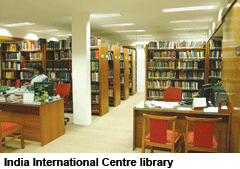 “We say sorry for sciences, but social science and humanities are our forte,” says Dr. Majumdar, revealing that he is particularly proud of its India Collection, which was donated by the British Council in 1961-62; a Himalayan Collection (700 volumes), and the Bilgrami Collection (500 mainly on history). The Japan Foundation has donated 250 books in English on Japan and Buddhism. “On average, usage in a library is only about 20 percent of the volumes,” he says, whereas in this library it is 40 percent and “if you include those who read the books in the library itself, it goes up to 60 percent,” says Majumdar. India’s vice president Hamid Ansari is a regular visitor. Verdict: small but beautiful.
“We say sorry for sciences, but social science and humanities are our forte,” says Dr. Majumdar, revealing that he is particularly proud of its India Collection, which was donated by the British Council in 1961-62; a Himalayan Collection (700 volumes), and the Bilgrami Collection (500 mainly on history). The Japan Foundation has donated 250 books in English on Japan and Buddhism. “On average, usage in a library is only about 20 percent of the volumes,” he says, whereas in this library it is 40 percent and “if you include those who read the books in the library itself, it goes up to 60 percent,” says Majumdar. India’s vice president Hamid Ansari is a regular visitor. Verdict: small but beautiful.
In sum, libraries are next in importance to schools and colleges in educating the public. But with the advent of computers and the internet and search engines, many people regret that these venerable institutions where people “lower their voices and raise their minds”, have outgrown their use-fulness. Google could do the work of a library — and that, too, in the comfort of one’s home, say sceptics. The library will soon become obsolete, they assert.
But I believe they are wrong. By and large, libraries have adapted to the internet age and got themselves ‘wired’. They have interacted with architects and designers to integrate the new technologies with traditional know-ledge-resourced facilities. The internet tends to isolate people. The library integrates them, since it is a social and equalising space. In developing countries like India, students and the general public who cannot afford to own a computer, can learn computing skills at a ‘wired’ public library.
Vivian Reding of the European Commission put it in essence in a recent talk: “Libraries play a fundamental role in our society. They are the collectors and stewards of our heritage; they are organisers of the knowledge in the books they collect — adding value by cataloguing, classifying and describing them; and, as public institutions, they assure equality of access to all citizens. They take the knowledge of the past and present, and lay it down for the future.”